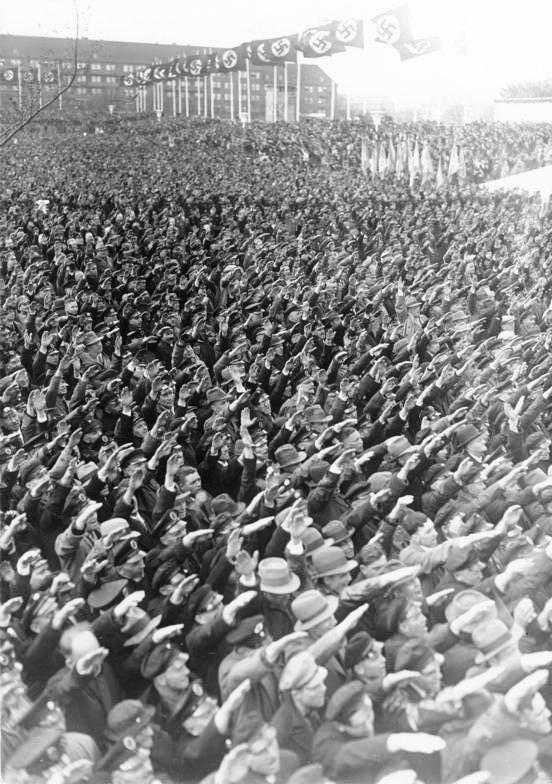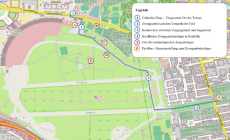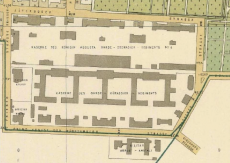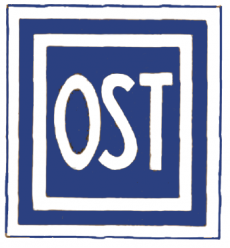Walking Tour of Tempelhof Field: 5. Contradictions between the past and the present
Deutsch
Here on the runway, it is hard to imagine events that took place so long ago. Once you learn of the history of this place, it becomes clear how much pain, suffering, and death happened here. Today, Tempelhof Field is a setting for local recreation, and yet it is also a site of contradictions between the past and the present.
Tempelhof is a place of quiet, relaxation and sports – a refuge of rest and recreation in the middle of Germany’s hectic capital city. That’s why many like to call it a place of freedom. In fact, the Berlin City Management for Urban and Environmental Development officially dedicated the field as “Tempelhof Freedom” (Tempelhofer Freiheit). The name “Tempelhof Freedom” can be found again and again in many books, travel guides and websites. Unfortunately, the usage of the word “freedom” in direct correlation to Tempelhof Field strongly indicates that Berliners are neglecting to address and remember a time when the airport and airport grounds were anything but relaxing or quiet – let alone “free.”
The historians of the Berlin History Workshop (Berliner Geschichtswerkstatt e.V.) and local activists have publicly expressed their dissatisfaction and disapproval of the “Tempelhof Freedom” name. To them, the name reflects and reinforces the general tendency of the German public to forget the past. In 2012 they published a booklet entitled “No place of freedom – Tempelhof Field 1933-1945” (Kein Ort der Freiheit – Das Tempelhofer Feld 1933-1945), which emphasized their position on the matter. In the booklet, activist Andreas Bräutigam stated that he wants to commemorate “the dark past of Tempelhof Field.”a

Mai 1, 1935 with over a million members of the national-socialist party on Tempelhof Field.
Source: Bundesarchiv, Bild 102-04481B / CC-BY-SA, http://commons.wikimedia.org/wiki/File:Bundesarchiv_Bild_102-04481B,_Berlin,_Maifeier_auf_dem_Tempelhofer_Feld.jpg
The concentration camp, the prison at Columbiadamm, the exploitation of laborers for munitions production and Nazi propaganda all contradict the symbolic freedom of Tempelhof Field. Perhaps one of the most public and significant cases of the anti-freedom position of the airport comes from a massive Nazi propaganda production on May 1st, 1933. May Day–the German Workers holiday, which is still observed today– was initially celebrated by the Nazis at Tempelhof Field (see picture). In the 2012 booklet, the historians of the Berlin History Workshop recalled that “Albert Speer took on the organization of the event and arranged to have the 450,000 square meter space enhanced with a grand stand which had the capacity to seat 13,000 people – and upon which Hitler held a speech. In addition, flags were positioned in a hill-like form and lit with a giant spotlight.“b
Tempelhof Field was not only an authentic location of Nazi propaganda; it also served as the starting point for many planes as they took off to engage in battles throughout Europe, where they, as stated in the 2012 booklet, “buried cities in soot and ashes. A particularly abhorrent example of this is the brutal suppression of the Warsaw Ghetto Uprising late in the summer of 1944, in which the Ju 87 (Stuka) dive-bombers constructed at Tempelhof Airport were present.”c
The list of the Nazi crimes committed at Tempelhof Field is long, but in comparison the historical research on the topic is only emerging. Very few people are against the current recreational use of the airport grounds, but, given the history, the name “Tempelhof Freedom” seems cynical. Above all, clarification and education about the subject is lacking. For this reason, the Berlin History Workshop is advocating for a “Memorial and Education Center on the Tempelhof Field.”d
Walking along the flight line to the second runway, you still get a feeling off the air traffic at the former Tempelhof Airport.
Boris Klein
Read on
- Walking Tour Tempelhofer Feld (PDF for printing, in German)
- Berliner Geschichtswerkstatt e. V. (Hg.), Kein Ort der Freiheit – Das Tempelhofer Feld 1933-1945. Konzentrationslager – Luftwaffenstützpunkt – Rüstungszentrum. Beiträge zur gedenkpolitischen Debatte über den Flughafen Tempelhof, Berlin 2012.
Notes
- Andreas Bräutigam, Geleitwort, in Berliner Geschichtswerkstatt e. V. (Hg.), Kein Ort der Freiheit – Das Tempelhofer Feld 1933-1945. Konzentrationslager – Luftwaffenstützpunkt – Rüstungszentrum. Beiträge zur gedenkpolitischen Debatte über den Flughafen Tempelhof, Berlin 2012, p. 5-6 (back)
- Angelika Königseder, Täterorte in Gedenkpolitik und Erinnerungskultur: Das Tempelhofer Feld, in Berliner Geschichtswerkstatt e. V. (Hg.), Kein Ort der Freiheit – Das Tempelhofer Feld 1933-1945. Konzentrationslager – Luftwaffenstützpunkt – Rüstungszentrum. Beiträge zur gedenkpolitischen Debatte über den Flughafen Tempelhof, Berlin 2012, p. 71-79 (back)
- Mirko Assatzk, Die militärische Nutzung des Tempelhofer Feldes unter der nationalsozialistischen Herrschaft, in Berliner Geschichtswerkstatt e. V. (Hg.), Kein Ort der Freiheit – Das Tempelhofer Feld 1933-1945. Konzentrationslager – Luftwaffenstützpunkt – Rüstungszentrum. Beiträge zur gedenkpolitischen Debatte über den Flughafen Tempelhof, Berlin 2012, p. 11-20 (back)
- Hans Coppi, Für einen Gedenk- und Lernort auf dem Tempelhofer Feld, Berliner Geschichtswerkstatt e. V. (Hg.), Kein Ort der Freiheit – Das Tempelhofer Feld 1933-1945. Konzentrationslager – Luftwaffenstützpunkt – Rüstungszentrum. Beiträge zur gedenkpolitischen Debatte über den Flughafen Tempelhof, Berlin 2012, p. 7-10 (back)







